The Thai Constellation Monstera, a variant of Monstera deliciosa, is a botanical masterpiece characterized by its distinctive variegated leaves. Native to the tropical rainforests of Central America, this particular variant has garnered significant attention and admiration from botanists and plant aficionados around the world.
Why are Thai Constellation Monsteras so expensive? The primary reasons can be traced back to its limited supply, due to unique propagation challenges, and its skyrocketing demand, fueled by its unparalleled appearance and the rising trend of indoor plant collecting.
This article offers a comprehensive exploration of the Thai Constellation Monstera’s rarity, its associated costs, potential alternatives, the intricacies of its variegation, and detailed care guidelines. As we journey through each facet, we’ll uncover the nuances that position this plant as both a botanical rarity and a sought-after luxury.
Reason 1: The Rare Supply of Thai Constellation Monsteras
In the indoor plant hobby, rarity often translates to value. And Thai Constellation Monsteras are a prime example.
The Thai Constellation Monstera doesn’t play by the same rules as its green-leaved cousins. Propagating this beauty is akin to a scientific art. Certain variegated plants, like our star Monstera, have cells that don’t reproduce as predictably as non-variegated ones. This unpredictability leads to fewer successful offspring and, therefore, a limited supply in the market.
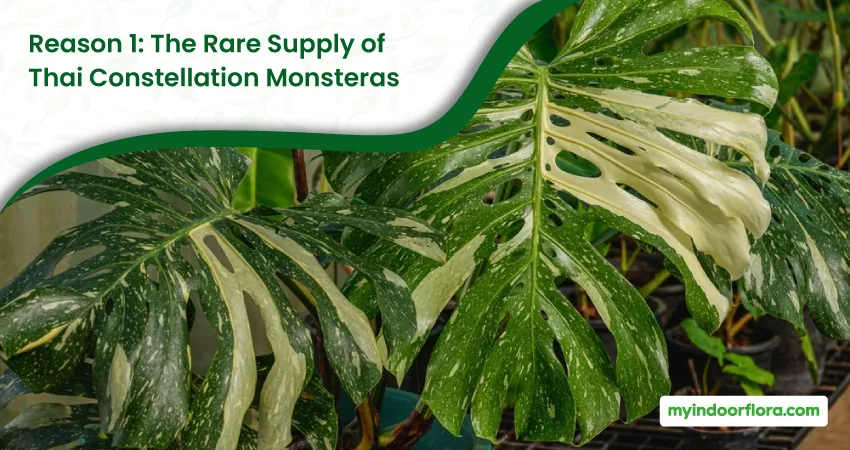
Few have the expertise or patience to cultivate the Thai Constellation Monstera. Specialized nurseries are few and far between, further limiting the plant’s availability. This scarcity, coupled with the propagation challenge, creates a supply bottleneck.
Reason 2: High Consumer Demand
In an age where social media dictates trends, the Thai Constellation Monstera reigns supreme in the plant kingdom.
Scroll through any plant lover’s Instagram feed, and the chances are high you’ll come across this variegated beauty. With the digital age propelling houseplant culture forward, the Thai Constellation’s unique patterns make it a showstopper. Its rare appearance makes it a prime candidate for bragging rights among collectors.

Beauty lies in uniqueness. The unpredictable variegation ensures that no two Thai Constellations are alike. This individuality resonates with collectors who seek out the extraordinary.
Reason 3: The Unique Variegation (No Two Plants Are the Same)
Unpredictability is the name of the game with Thai Constellation Monsteras.
Variegation is a result of a mutation, leading to a lack of chlorophyll in parts of the plant. This phenomenon, as studied in the International Journal of Plant Biology, can occur naturally or be induced. In the case of the Thai Constellation, it’s a naturally occurring, yet unpredictable, process.
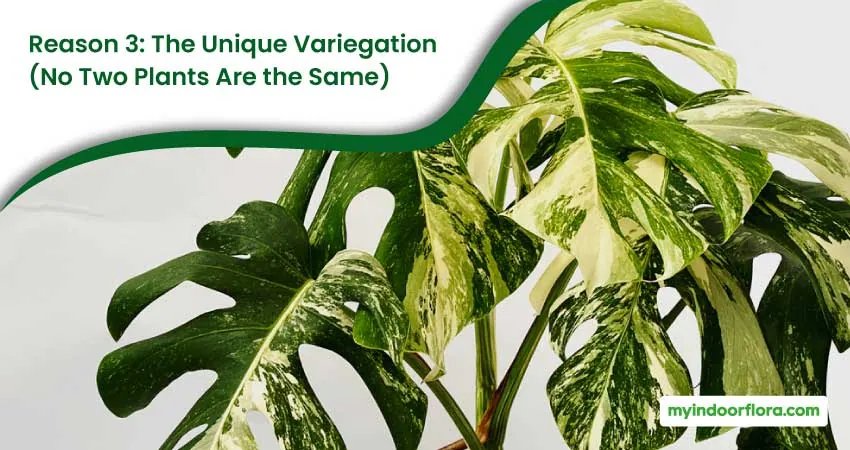
Imagine owning an artwork, knowing there’s none like it in the world. That’s the allure of the Thai Constellation Monstera. Each plant is a masterpiece with its unique pattern, making it a collector’s dream.
Reason 4: Slower Growth Rate Compared to Other Monsteras
Patience is a virtue, more so for those growing the Thai Constellation.
While a standard Monstera deliciosa might reach maturity within a year, the Thai Constellation takes its sweet time. Variegated plants, due to their lack of chlorophyll in certain areas, often grow slower. This means longer cultivation times and delayed gratification for both growers and buyers.

Reason 5: Specialized Care and Maintenance Requirements
With great beauty comes great responsibility. The Thai Constellation Monstera demands its fair share of care.
This plant isn’t for the faint-hearted. Due to its variegation, the Thai Constellation is more susceptible to sunburn, requiring a delicate balance of light. Too much, and the white patches can scorch; too little, and the plant won’t thrive.

Ensuring the plant retains its variegation requires expertise. Factors like optimal soil pH, right watering frequency, and precise light conditions come into play. One misstep, and the plant might revert to its green form or, worse, perish.
Reason 6: Global Trade Challenges (Import and Export Restrictions)
In the plant world, borders are more than just geographical boundaries.
Many countries, keen on protecting their native flora and preventing the spread of plant diseases, impose strict import and export regulations. The Thai Constellation Monstera, given its rarity, often falls under these stringent rules. This not only impacts its availability but also drives up its price.
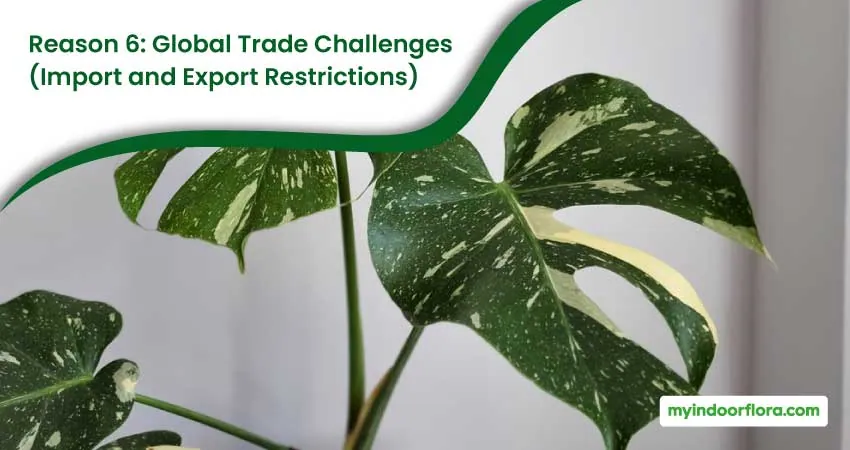
Reason 7: Trend-Driven Popularity and the Premium Attached
In a world where trends change at the drop of a hat, the Thai Constellation Monstera stands firm.
Trends have the power to elevate the ordinary to extraordinary. As houseplants became the new must-haves, the Thai Constellation, with its unique appearance, became a premium item. Its rarity and beauty combined make it a status symbol in the plant world.
Monstera Thai Constellation Price
Understanding the value of the Thai Constellation Monstera requires a closer look at its pricing nuances.
Factors Influencing Price
- Size and Maturity: Younger plants tend to be cheaper, but as the plant matures and its variegation becomes more prominent, the price increases significantly.
- Source of Purchase: Buying directly from a nursery might be less expensive than procuring it from a boutique plant shop or an online reseller.
- Local vs. Imported: Plants grown locally, avoiding import fees and duties, may be priced lower than imported ones.
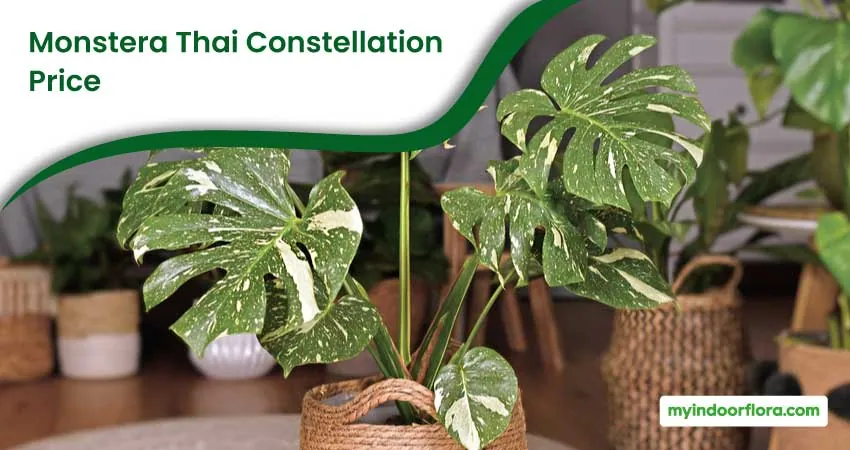
Typical Price Range
A small Thai Constellation Monstera could range from $50 to $200, whereas mature plants might fetch prices upwards of $700 or more.
Is There Any Alternative For Thai Constellation Monstera?
For those charmed by the Thai Constellation but deterred by its price, there are alternatives to consider.
Monstera Albo Borsigiana
This is another variegated Monstera variety. It has a similar charm with white streaks but tends to have larger sections of white compared to the speckled appearance of the Thai Constellation.
Monstera Karstenianum ‘Peru’
Though not variegated, its unique textured leaves and compact growth make it an attractive alternative for those looking for something different.
Variegated Philodendron
While not a Monstera, its striking variegation makes it a popular choice for those seeking the aesthetic appeal of the Thai Constellation without the hefty price tag.
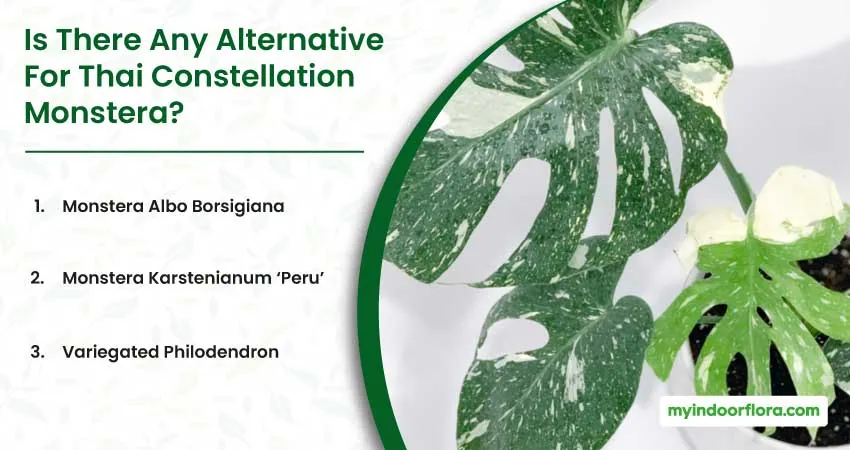
Can a Thai Constellation Become More Variegated?
The variegation in a Thai Constellation is unpredictable, but certain factors might influence its prominence.
- Role of Light: Exposing the plant to indirect but bright light can sometimes encourage variegation. However, direct sunlight can scorch the white parts, so care is essential.
- Genetics: While environment plays a role, the plant’s genetics are a significant factor. Some plants might naturally develop more variegation as they grow, while others remain consistent.
- Pruning Techniques: Selective pruning can sometimes promote variegated growth. By trimming non-variegated shoots, the plant can be encouraged to produce more variegated leaves.

Monstera Thai Constellation Care
Caring for this gem requires diligence and understanding.
Lighting
Bright, indirect light is ideal. Too much direct sunlight can lead to sunburn, especially on the variegated sections.
Watering
The Thai Constellation prefers evenly moist soil. It’s essential to water when the top inch of the soil feels dry, ensuring the roots aren’t sitting in water, which can lead to rot.
Humidity and Temperature
A humid environment, mimicking its tropical origins, is ideal. Maintaining a humidity level of around 60% and ensuring temperatures between 65°F and 75°F will keep the plant happy.
Feeding
During the growing season, a balanced, water-soluble fertilizer every 2-4 weeks can support its growth. In dormant periods, reduce feeding.
Repotting
When the plant outgrows its pot, or the soil becomes too compacted, repotting becomes necessary. This usually occurs every 2-3 years. Opt for a pot that’s 2 inches larger in diameter than the current one.
Conclusion
From its unpredictable variegation to the challenges in cultivation and global trade, the Thai Constellation Monstera’s pricing is a result of a perfect storm of factors. Its allure lies not just in its beauty but in the story behind each leaf and the journey it undertakes from propagation to a collector’s prized possession. In understanding its value, one truly appreciates the intricacies of nature and the lengths humans go to preserve and cherish it.
